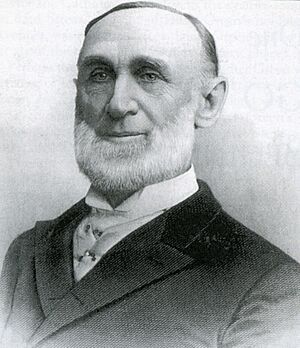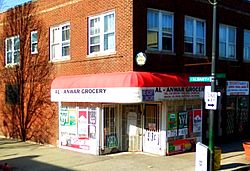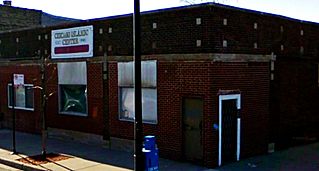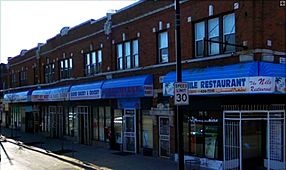Chicago Lawn, Chicago facts for kids
Quick facts for kids
Chicago Lawn
|
|
|---|---|
| Community Area 66 - Chicago Lawn | |
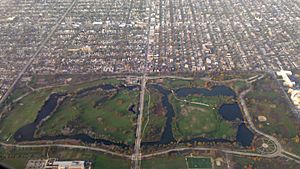
The 323-acre Marquette Park.
|
|
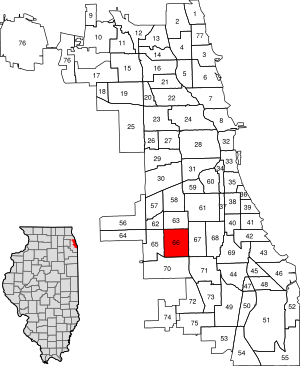
Location within the city of Chicago
|
|
| Country | United States |
| State | Illinois |
| County | Cook |
| City | Chicago |
| Neighborhoods |
list
|
| Area | |
| • Total | 3.49 sq mi (9.04 km2) |
| Population
(2020)
|
|
| • Total | 55,931 |
| • Density | 16,024/sq mi (6,187/km2) |
| Demographics (2020) | |
| • White | 2.4% |
| • Black | 39.7% |
| • Hispanic | 55.4% |
| • Asian | 0.5% |
| • Other | 1.9% |
| Time zone | UTC-6 (CST) |
| • Summer (DST) | UTC-5 (CDT) |
| ZIP Codes |
parts of 60629 and 60636
|
| Median income 2020 | $36,278 |
| Source: U.S. Census, Record Information Services | |
Chicago Lawn is a vibrant neighborhood in Chicago, Illinois. It is one of the 77 official "community areas" that make up the city. You can find it on the southwest side of Chicago.
Chicago Lawn is surrounded by other neighborhoods like Gage Park and West Lawn. It is about 13 kilometers (8 miles) southwest of the famous Loop downtown area. Many local people often call the area "Marquette Park" because of the large and well-known park located right in its center.
Contents
A Look at Chicago Lawn's Past
The Chicago Lawn area was first established by John F. Eberhart in 1871. At first, it was mostly farmland with only a few small settlements. In 1889, it officially became part of the city of Chicago.
However, it wasn't until the 1920s that Chicago Lawn really started to grow. Between 1920 and 1930, its population jumped from 14,000 to 47,000 people! Many new residents came from other Chicago neighborhoods. These included people of German and Irish backgrounds. Soon after, people from Poland, Bohemia, and Lithuania also moved to the area.
Most of the new residents were Protestants, but Chicago Lawn also became home to many Roman Catholic churches and schools. Today, there are six Catholic groups that work together in the area. By 1940, the population reached almost 50,000 people.
Big Bakery Comes to Town
In 1941, a major company called the National Biscuit Company (Nabisco) decided to build a huge bakery in Chicago Lawn. When it was finished, it was the largest bakery of its kind in the entire world! The bakery was so successful that it was made even bigger in the late 1990s.
Lithuanian Community's Impact
The Lithuanian community has played a very important role in Chicago Lawn. They created many organizations and businesses. These included some of the richest savings and loan banks in the city.
The Sisters of Saint Casimir, a group of Lithuanian nuns, founded Holy Cross Hospital in 1928. They also started Maria High School in 1952. The Nativity of the Blessed Virgin Mary Church was built in 1927. It was created as a special church for Lithuanians, and services are still held in the Lithuanian language today.
In Marquette Park, there is a special monument. It was built by the Lithuanian community to remember two Lithuanian pilots, Stasys Girėnas and Steponas Darius. They sadly died in a plane crash in 1933 while flying a plane called the Lituanica.
Changes in the Community
| Historical population | |||
|---|---|---|---|
| Census | Pop. | %± | |
| 1930 | 47,462 | — | |
| 1940 | 49,291 | 3.9% | |
| 1950 | 50,211 | 1.9% | |
| 1960 | 51,347 | 2.3% | |
| 1970 | 48,508 | −5.5% | |
| 1980 | 46,568 | −4.0% | |
| 1990 | 51,243 | 10.0% | |
| 2000 | 61,412 | 19.8% | |
| 2010 | 55,628 | −9.4% | |
| 2020 | 55,931 | 0.5% | |
Like many neighborhoods, Chicago Lawn has seen its population change over the years. In the 1960s, there were important events related to the Civil Rights Movement. In 1966, Martin Luther King Jr. led a march into Marquette Park. This march was part of efforts to ensure fair housing for everyone.
By the 1990s, white residents were the largest group in Chicago Lawn. However, over the next ten years, the neighborhood became much more diverse. By 2000, African Americans made up the largest group, followed by Hispanic residents. There are also Jewish and Palestinian communities in the area. Some Irish, Poles, and Lithuanians still live there too.
Growing Arab Community
The Arab community in Chicago Lawn has a rich history. By the 1920s, people from Arab countries began moving to Chicago. More Palestinian Muslims arrived after 1948. Many Arab families settled in Chicago Lawn and the nearby Gage Park neighborhood.
In the 1950s, Palestinian families started moving into apartments and homes in the area. By the 1970s, they had formed a strong community. They also created a business district with stores and restaurants that served Arab customers. The Arab community founded the Chicago Islamic Center and Mosque on 63rd Street. Today, Chicago Lawn still has one of the largest groups of Palestinians in Chicago.
Schools and Libraries
Chicago Public Schools runs the public schools in Chicago Lawn.
- Many elementary and K-8 schools serve the area. These include Claremont, Eberhart, Fairfield, Marquette, McKay, Morrill, Tarkington, Tonti, Hernandez, and Sandoval.
- Most students in the community attend Gage Park High School. Some parts of Chicago Lawn are zoned for Harper High School, Hubbard High School, or Bogan High School.
The Chicago Public Library also has a branch in Chicago Lawn. The Chicago Lawn Branch library opened on December 1, 1960, and serves the community.
Famous People from Chicago Lawn
Many talented individuals have lived in or grown up in Chicago Lawn.
- Mike Disa (born 1965) is a film director and animator.
- Carl L. Klein was a member of the Illinois House of Representatives.
- Tom McAvoy (1951–2019) was a Republican politician who served in the Illinois House of Representatives.
- Michael Madigan (born 1942) has been the Speaker of the Illinois House of Representatives for many years.
- Walter C. McAvoy (1904–1990) was also a Republican politician in the Illinois House of Representatives.
- Tony Piet (1906–1981) was a professional baseball player. He played for the Chicago White Sox.
- Michael Peña (born 1976) is a well-known actor and musician. He won an award for playing activist César Chávez in a movie.
- John C. Reilly (born 1965) is a famous actor and comedian. He was nominated for an Academy Award for his role in the musical film Chicago.


